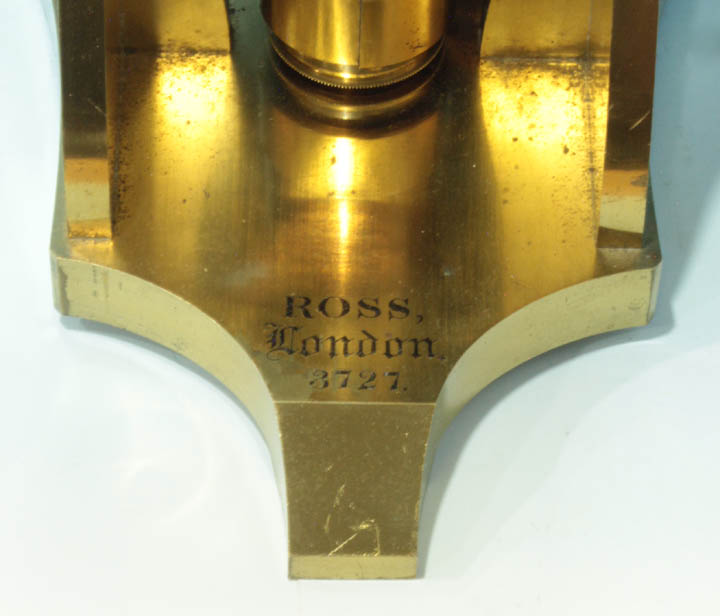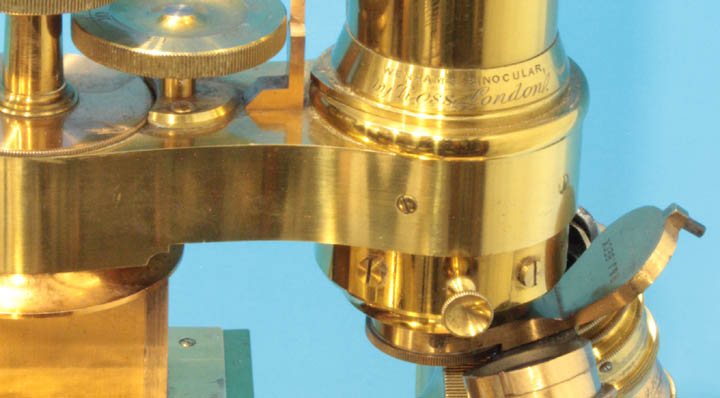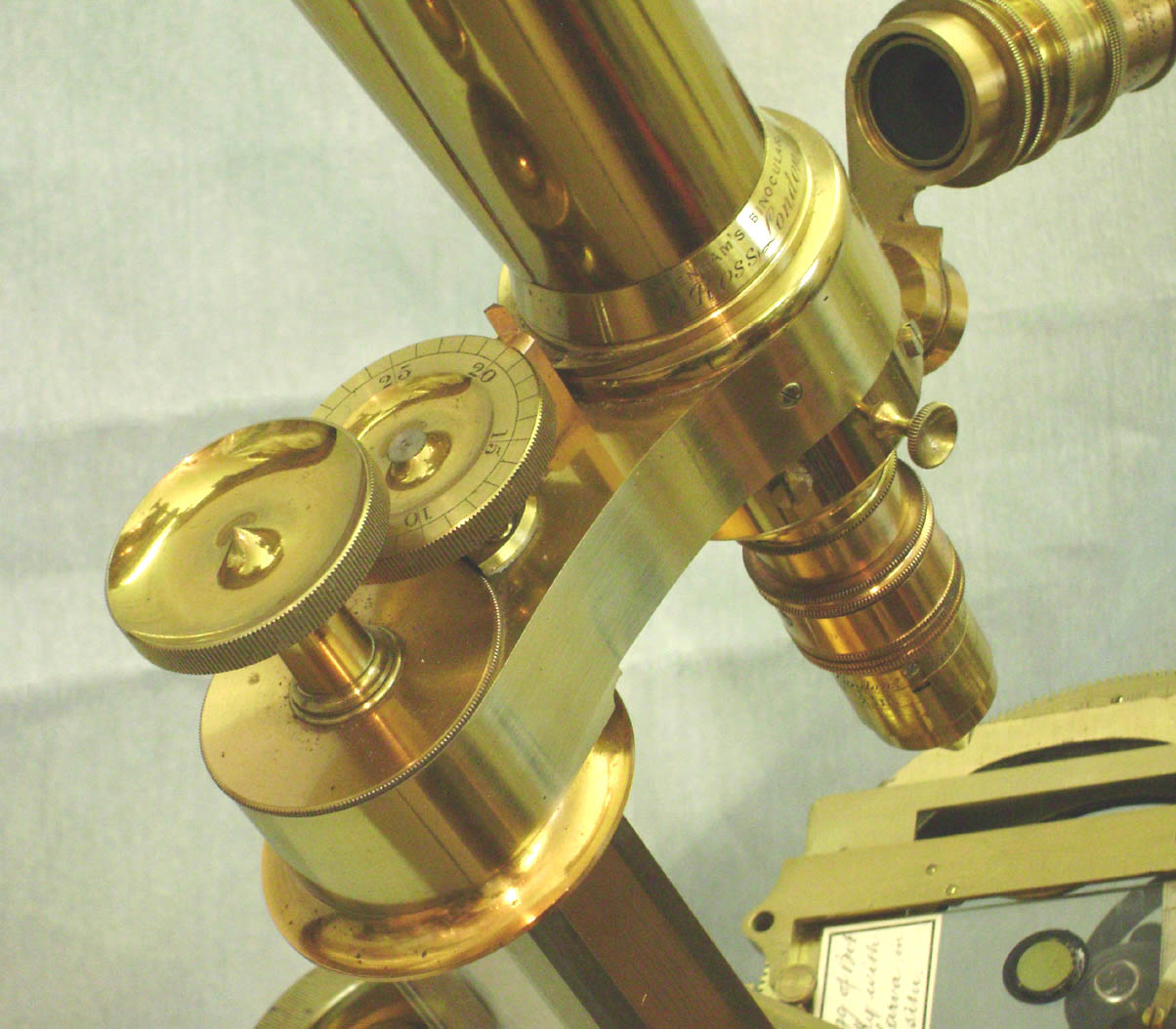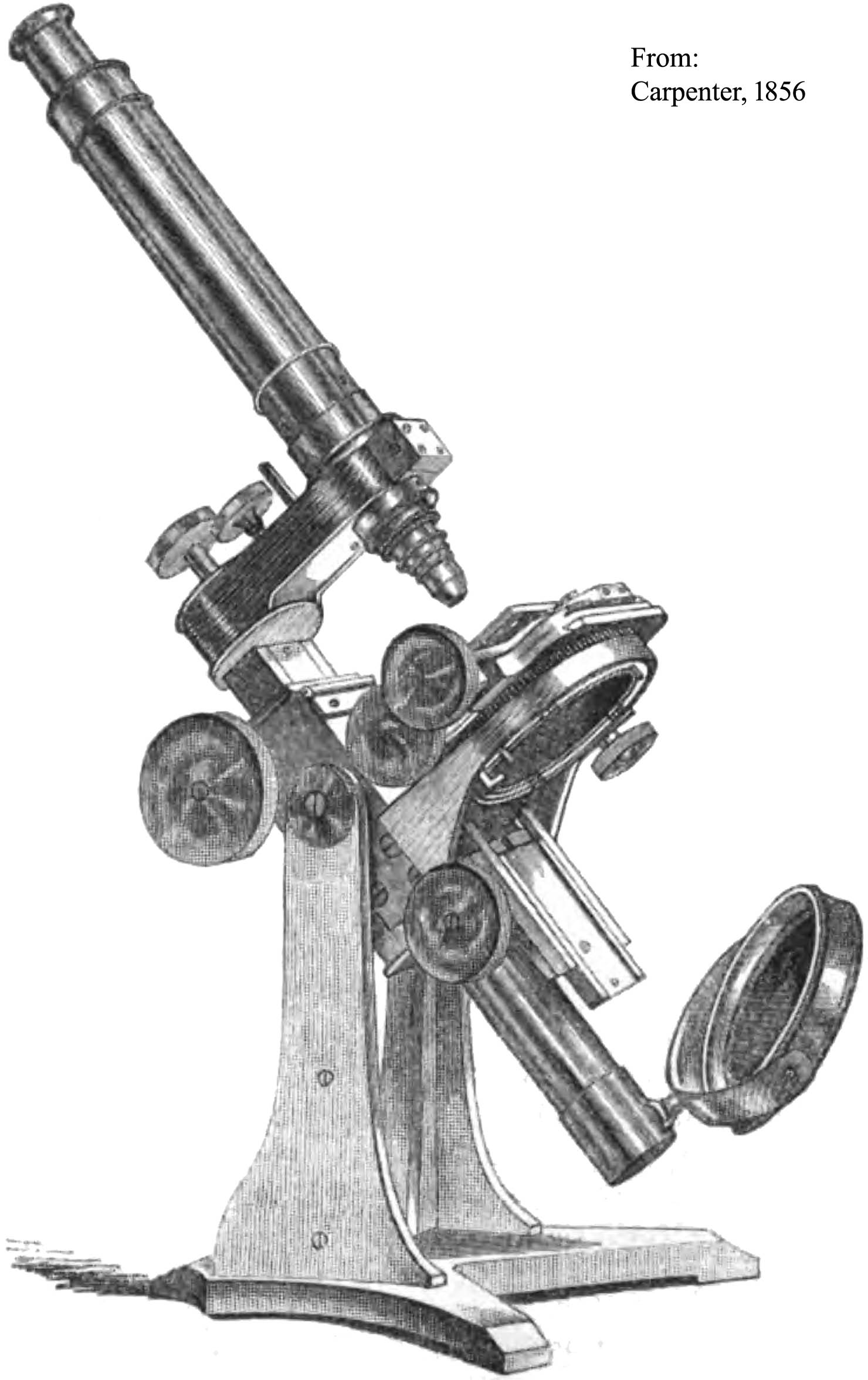ROSS MICROSCOPE
c. 1873
SIGNED: ROSS, London, 3727
SERIAL NUMBER: 3727
MODEL: LARGE
or LARGE FIRST
CLASS
or T. ROSS 1861 EXHIBITION-MODEL MICROSCOPE
AUTHORS: Barry Sobel and Jurriaan de Groot
Editor: Joseph Zeligs
Please Click On Any Picture for a
Larger Version
DESCRIPTION:



Signed in block Capital letters on the Foot: ROSS
.
In addition, signed in old English on the next line London.
and then the serial number 3727.
on the third
line. It is also signed on the optical tube: WENHAM'S
BINOCULAR, by Ross London
.
The massive rectangular bar-limb is supported between two
trunions arising from the foot and each supported by braces facing 90 degrees inward. The inclination joint has a lever tension adjustment on the right to maintain the inclination chosen. A large knob fastens the bar to the
arm and is tensioned by a strong spring. Coarse focusing is by rack and pinion, fine is by a graduated knob
to a long-lever screw. There are a number of adjustment screws used to assure good fitting of the bar in its housing and the optimal adjustment of the rack and pinion mechanism.
There is a graduated mechanical stage which can rotate
manually, or by rack and pinion control from the underside of the stage; the pinion can be pulled down to disengage it and thereby allow manual rotation.
The substage can be moved up or down via rack and pinion motion. The substage has fine centering controls and its rotation is also graduated, and can rotate via rack and pinion adjustment, similar to the stage above.
The large mirror has a plane side and a concave side
and has a triple articulation leading to the gimbal. The mirror support can slide up or down the tailpiece.
This is the largest microscope ever made by the
Ross company and is second in complexity only to the Wenham Ross
Radial. It is also one of the largest brass microscopes in this collection. Other than modern microscopes, in this collection only the Bulloch Congress model is heavier. This Ross came in a glass-fronted case with a separate mahogany case for an extensive set of accessories, many of which are still present.
Accessories include:
- Three pairs of Eyepieces labelled A,B, and C, and a single D
signed 'Kellner's orthoscopic Ross London.'
- Wenham-type Parabolic Darkfield Condenser
- Nosepiece Analyzer
- Substage Polarizer
- Substage Stack of Selenites which can each be individually rotated and used in combinations or separately.
- Achromatic Substage Condenser signed
Ross London
with
double wheel of apertures
- Another Substage Condenser with a single wheel of apertures
- Stage Forceps
- Three signed Lieberkuhn reflectors
- A Beck Vertical Illuminator
- A Double Nosepiece
- Six Objectives
- Substage Ground Glass Fitting
- A large Frog or Fish Plate
- A Monocular Tube Extension (Drawtube)
HISTORY OF ROSS BAR-LIMB MICROSCOPES
 Andrew Ross founded his business in 1830, and like James
Smith, collaborated with J.J. Lister, the man who invented a
mathematical method of producing objectives which were both achromatic and aplanatic.
Ross's early instruments were constructed initially in a fashion
similar to the Jones-most-improved models, followed by a construction similar to that of the
Andrew Ross founded his business in 1830, and like James
Smith, collaborated with J.J. Lister, the man who invented a
mathematical method of producing objectives which were both achromatic and aplanatic.
Ross's early instruments were constructed initially in a fashion
similar to the Jones-most-improved models, followed by a construction similar to that of the Lister Limb
and he continued this practice until the 1840's when he developed his version of the bar-limb, a very stable design and from then on also supported his larger stands on the classic Y-shaped foot with two upright supports. Ross' Bar-limb construction was first pictured in the Physiological Journal of 1843. Early examples used a triangular bar, which was later replaced by a square one and finally on the largest and heaviest version, a rectangular one like seen here. Andrew died in 1859 and his son Thomas Ross carried on the business, and displayed a microscope similar to this one, (except for being monocular) in the 1861 Great Exhibition. Thomas Ross died about 1870.
THE BINOCULAR TUBE:
Francis Wenham, for some time a consultant working for Ross, invented one of the first long-lived designs for a binocular tube about 1860-1861. Wenham's binocular, utilizing a single, and usually removeable asymetrical prism, was incorporated into the instrument seen here. Although Cherubin invented a binocular
microscope that actually used two monocular microscopes side by side, it was Professor J.L. Riddell
of New Orleans who invented the first binocular system that did not use two separate microscopes, but used two separate prisms and a single objective to direct the image to two tubes. Although Riddell's invention was in the middle of the 19th century (1854), it seems it was slow to be adapted, likely due to its easily mis-aligned adjustments which were difficult to keep properly adjusted for binocular vision.
The Ross company went on to produce optical products well into the twentieth century, although large high-quality microscopes became less important as the years went by. The engraving to the right (taken from the 1856 edition
of Carpenter's The Microscope and Its Revelations), shows a microscope virtually identical to the present one shown here.
In the 1883 edition of Carpenter, the book shows a very slightly different model, where tension on the inclination adjustment acted on a slotted arc instead of directly on the inclination joint. By 1883, Ross' catalog of microscopes shows only the Lister limb Ross-Zentmeyer stands and this model, although presumably available by special order, was no longer part of the standard offerings. As Carpenter said, referring to the bar-limb construction:
'Its disadvantages consist in the want of
portability...and liability to tremor in the image when the highest powers are used, through the want of support to the body tube along its length'...and this has 'induced Messrs. Ross to adopt the Jackson-model...'
The Jackson model is essentially a Lister Limb with the substage slot, in which the substage travels when focused, machined to be in the same plane as the one for the limb. Thus the 1883 Ross Microscope catalog featured the Lister-Limb based Ross-Zentmeyer construction. Powell and Lealand did not follow suit however and continued to use Bar-Limb construction into the twentieth century, although in some early examples they used a support from the top of the optical tube to the back of the arm to form a more rigid support to the tube.
CONDITION:
This binocular microscope is in fine overall working condition.
There are minor scattered losses and a a few fine scratches as shown in the images. The mirrors are for the most part intact with minor losses to the silvering. Some screw slots are slightly worn due to difficulty in adjusting them.
When it came to me from an auction, many years ago, this microscope was missing its rack. A replacement rack was hand made by us in October 2023. After an adjustment to the position of the partly damaged pinion, and the proper adjustment of the screws on the rear of the microscope, the coarse focus works very well.



 Andrew Ross founded his business in 1830, and like James
Smith, collaborated with J.J. Lister, the man who invented a
mathematical method of producing objectives which were both achromatic and aplanatic.
Ross's early instruments were constructed initially in a fashion
similar to the Jones-most-improved models, followed by a construction similar to that of the
Andrew Ross founded his business in 1830, and like James
Smith, collaborated with J.J. Lister, the man who invented a
mathematical method of producing objectives which were both achromatic and aplanatic.
Ross's early instruments were constructed initially in a fashion
similar to the Jones-most-improved models, followed by a construction similar to that of the